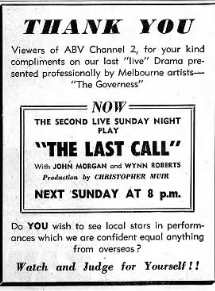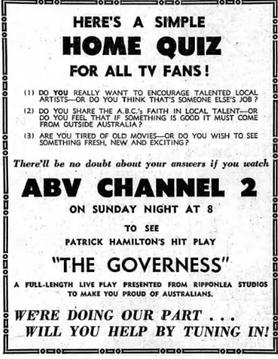Related Research Articles

Annette Andre is an Australian actress best known for her work on British television throughout the 1960s and 1970s.
Raymond Edward Menmuir was a British-Australian director and producer. His career included producing 44 episodes of The Professionals and directing 12 episodes of Upstairs, Downstairs. He also produced an Australian version of The Professionals called Special Squad for the Ten Network in 1984.

Stormy Petrel is an early Australian television drama. A period drama, the 12-episode serial told the story of William Bligh and aired in 1960 on ABC. It was the first live TV serial from the ABC.
Box for One is a live television play which has been presented three times, twice on British broadcaster BBC and once on Australian broadcaster ABC. It is a drama about a "spiv", and the entire 30-minute drama takes place in a London telephone box. It was written by Peter Brook.
Roundabout is a television movie, or rather a live television play, which aired on Australian television in 1957. Broadcast 4 January 1957 on ABC station ABV-2, it is notable as the first example of television drama produced in Melbourne.

Blue Murder is an Australian live television play which aired in 1959 on ABC. Broadcast live in Sydney on 2 December 1959, a kinescope ("telerecording") was made of the broadcast so it could be shown in Melbourne.

Boy Round the Corner is an Australian film which aired in 1962. Broadcast live on ABC, it was set in Sydney but produced in Melbourne. Australian TV drama was relatively rare at the time.
Citizen of Westminster is an early example of Australian television drama which aired on ABC. A one-off play set in England, it aired live on 8 October 1958 in Sydney, and kinescoped for showing in Melbourne on 30 November 1958. Australian TV drama was relatively rare at the time.
The House on the Corner is an early Australian television program which aired from 1957 to 1958. A 10-minute segment on Sydney station ATN-7, it was a drama about a family, and was produced by the Christian Television Association. Cast included Harry Howlett, his wife also played a role, as well as Rosemary Barker and Annette Andre.
David Cahill was an Australian actor, writer-producer and director, notable for his work directing for television from its introduction in the 1950s through to 1970s. It has been claimed he was one of the best directors working in early Australian TV. His pioneering credits at ATN7 included Australia's first religious TV series, featuring a teenaged Annette Andre, and first long-running dramatic serial starring Muriel Steinbeck.
An Enemy of the People is a 1958 Australian television play starring James Condon. It was based on the 1882 play by Henrik Ibsen and was updated to a contemporary Australian setting. It was broadcast live.
Wuthering Heights is a 1959 Australian television play adapted from Emily Brontë's 1847 novel Wuthering Heights. It was directed by Alan Burke and based on a script by Nigel Kneale which had been adapted by the BBC in 1953 as a TV play starring Richard Todd. It was made at a time when Australian drama production was rare.

Act of Violence is a 1959 television play broadcast by the Australian Broadcasting Corporation. It was based on a play by Australian writer Iain Mac Cormick which had previously been broadcast in Britain in 1956. This was typical of Australian television at the time - most locally produced drama consisted of adaptations of overseas stories.

Last Call is a 1958 Australian TV play set in a South American country. It was directed by Christopher Muir.

The Governess is a 1958 television play broadcast by the Australian Broadcasting Corporation based on a play by Patrick Hamilton, which had been performed several times on Australian radio. It was directed by William Sterling who had previously directed an adaptation of Hamilton's Gaslight (1958).
Christopher Muir was an Australian director and producer, notable for his work in TV in the 1950s and 1960s. In the 1980s he was head of ABC Television drama.

The Merchant of Venice is a 1961 Australian television adaptation of the play by William Shakespeare that aired on 13 September 1961 in Sydney, and on 25 October 1961 in Melbourne.
Quiet Night is a 1941 Australian play by Dorothy Blewett.

"Antarctic Four" is the ninth television play episode of the first season of the Australian anthology television series Australian Playhouse.
The Slaughter of St. Teresa's Day was a 1960 Australian TV play based on the 1959 stage play of the same name by Peter Kenna.
References
- ↑ "Looking Ahead On Channel 2, ABN". ABC Weekly. 26 March 1958. p. 33.
- ↑ "TV Guide". The Age. 18 April 1959. p. 17.
- ↑ Vagg, Stephen (18 February 2019). "60 Australian TV Plays of the 1950s & '60s". Filmink.
- ↑ "Girl's Chance in Live Play". Sydney Morning Herald. 24 March 1958. p. 11.
- ↑ "Untitled". The Age. 1 April 1958. p. 25.
- ↑ If It's a Rose 1954 British TV at IMDb
- ↑ Vagg, Stephen (29 August 2020). "Annette Andre: My Brilliant Early Australian Career". Filmink.
- ↑ "My First Job – 'I didn't get stage fright on radio'". Annette Andre. 20 June 2018.